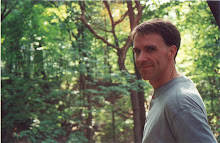Youngstown, Ohio: Pennsylvania Coal Town [Butler Institute of American Art]

Youngstown's Mahoning Valley lies where the Appalachians peter out into rolling hills and run-off rivers. Near the coal slips and river ports, you'll find cities built on hillsides. Down in the valley or near the port, you'll find the workers homes and the place of work. Halfway up the hill, just before you reach the downtown commerce district and wealthy mansions on the first ridge above the flood plain, you'll find the stodgy respectable homes of the merchants and foremen. And, like as not, you'll find a small-town merchant mixing civic pride with personal pomp and a Puritan work ethic by tending his house and lawn. So we find the man in Hopper's painting in Youngstown, Pennsylvania Coal Town.
In the painting, a man working in the side yard between his house and a neighbor's stops and leans on his rake to look in wonder or fear into the blinding sunlight that broadsides him like the Atomic Bomb flash that took place just two years previous to the 1947 painting. The man wears full-length white sleeves, a charcoal-gray vest, and light gray slacks, retaining formal costume during domestic chores. The residents of the other houses on the street are absent, post-apocalyptically. This simian man's hunched posture and lanky arms look like the man in Jean-Francoise Millet's  Man with a Hoe, which Hopper sketched while an art student. Jo identified the glum, lonely figure in Pennsylvania Coal Town as "a Pole." Perhaps she meant "prole."
Man with a Hoe, which Hopper sketched while an art student. Jo identified the glum, lonely figure in Pennsylvania Coal Town as "a Pole." Perhaps she meant "prole."
The Butler also had  Shoshone Cliffs, Wyoming, one of three watercolors that Hopper painted during an automobile trip to the West Coast in 1941. On the walls upstairs by the museum's library (named, coincidentally enough, the Hopper Resources Library, named not for Edward but for Frances T. and Eugene D. Hopper) was a photograph of "legendary painter Edward Hopper who served as juror." Hopper, hands behind his back, looks at paintings on the floor propped up against the Butler walls. He does not look happy. Afterward, Jo wrote to thank the director's mother for the hospitality, maybe to make up for the fact that Ed rejected a painting by her son, the Butler's director.
Shoshone Cliffs, Wyoming, one of three watercolors that Hopper painted during an automobile trip to the West Coast in 1941. On the walls upstairs by the museum's library (named, coincidentally enough, the Hopper Resources Library, named not for Edward but for Frances T. and Eugene D. Hopper) was a photograph of "legendary painter Edward Hopper who served as juror." Hopper, hands behind his back, looks at paintings on the floor propped up against the Butler walls. He does not look happy. Afterward, Jo wrote to thank the director's mother for the hospitality, maybe to make up for the fact that Ed rejected a painting by her son, the Butler's director.
The collection's centerpiece was Hopper predecessor Winslow Homer's Snap the Whip. Hopper's influence on American art after Homer was on view in the painting  To Have and Have Not, an oil painting based on a still from the movie. Another piece was titled like a Hopper: High Noon, New York. A painting by William Gropper titled
To Have and Have Not, an oil painting based on a still from the movie. Another piece was titled like a Hopper: High Noon, New York. A painting by William Gropper titled  Youngstown Strike showed a local scene of soldiers with rifles and wounded strikers.
Youngstown Strike showed a local scene of soldiers with rifles and wounded strikers.
The Butler's 75th anniversary celebration had just closed before I visited and had included a visit from legendary singer Tony Bennett, who also exhibited one of his many paintings. The 65th annual Midyear show was up, and the many Ohio artists in the show used native subjects from the state that were worthy Hopper subjects: farmhouses and classic office buildings; old eateries; industrial subjects from bolts to factory complexes.
20090217
157 Youngstown, OH: Pennsylvania Coal Town
Subscribe to:
Post Comments (Atom)




No comments:
Post a Comment